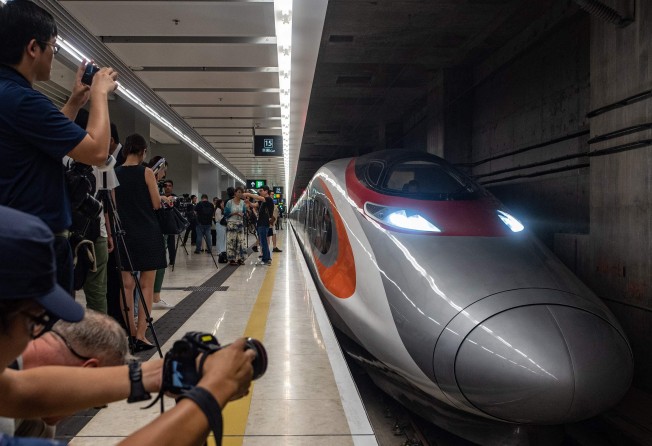No platform doors, but special measures to ensure no falls on tracks at Hong Kong high-speed rail link terminus, union leader says
Hong Kong Federation of Railway Trade Unions vice-chairman Tam Kin-chiu says crowd control and platform design will address issues, but calls out operator for lack of transparency over ‘hidden’ floors

It would be next to impossible for passengers to jump or fall onto rail tracks at the Hong Kong high-speed link terminus even without screen doors at station platforms, a workers’ union leader has said.
Citing special measures in place to prevent such incidents, Hong Kong Federation of Railway Trade Unions vice-chairman Tam Kin-chiu made the remarks ahead of the September 23 launch of the Guangzhou-Shenzhen-Hong Kong Express Rail Link. It is expected to serve about 80,000 commuters daily.
All eyes are on whether the much-hyped rail link, which has seen its share of controversies over cost overruns, delays and legalities, would provide smooth and comfortable rides free from accidents or disruptions.
Tam, who conducted a site visit last month at the link’s West Kowloon terminus, told the Post that procedures controlling passenger flows would ensure that trains would already be stationed at the platforms as each batch of commuters came through. As such, there would be no empty tracks for people to fall or jump on.
He added that the 14 platforms on the station’s B4 level where passengers are to wait for trains were also built with a special design. “Each platform is separated from one another without any interconnecting passageway.
“Unlike other train stations, commuters at the high-speed railway cannot casually walk across different platforms. This special arrangement is to safeguard passengers’ safety and the security of the railway.”
Tam added that the MTR Corporation, the rail link operator, did not build screen doors on the platforms because it wanted to “save costs”.

When the government requested an extra HK$19.6 billion (US$2.4 billion) in funding from the Legislative Council for the railway in early 2016, the MTR Corp pledged to contain the final cost at HK$84.4 billion and foot the bill for any extra overruns.
Tam said departing passengers would go through customs and immigration procedures on the B3 level with counters directing them to a floor below for their scheduled trains.
“But before passengers are allowed to proceed to their platform at level B4, the trains will already be there waiting for them to board,” he added. “Basically passengers won’t see empty rail tracks at the platforms.”
Addressing the recent disclosure of five “secret” floors at the terminus, including a B5 level providing a short-cut to rail platforms, Tam said as the 14 individual platforms on B4 were not connected, there was a practical need for another level in case workers or rescuers needed access to the tracks in an emergency.
“The B5 underpass is the only access to all the rail platforms. When rescue action is needed, this underpass will be very helpful.”
Tam added that every platform was equipped with a glass room where a supervisor from the MTR Corp would be stationed to offer help to passengers in need.
The other four floors of the terminus contained offices, ventilation and air-conditioning facilities, refuse collection and switch rooms, dining rooms, and other amenities.
But Tam criticised the MTR Corp, saying it lacked transparency and did not disclose the building plans for these areas, leading to accusations the rail giant and the government were involved in a cover-up.
Now because of their lack of transparency, speculations have been running wild
“I think the public should have been informed much earlier about the existence and operation of these hidden floors,” he said. “The MTR Corp should have respected the public’s right to know. Now because of their lack of transparency, speculations have been running wild.”
The areas in question, involving a total of 30,400 square metres, were not revealed until media reports surfaced recently. On Tuesday and Thursday night respectively, the Transport and Housing Bureau finally clarified the five hidden floors were not for passenger use and not under control by mainland authorities.
Under a so-called co-location arrangement, a part of the terminus would be leased to mainland officials for customs procedures. State laws would be enforced in this area. The joint checkpoint plan has raised concerns that it contravenes the Basic Law, Hong Kong’s mini-constitution, which states no mainland law shall apply on the city’s soil.
The bureau assured the public that only authorised staff with permits issued by the MTR Corp could access the recently disclosed floors for work, and all links to the port area staffed by mainland officers were locked by security systems.
On Friday, two men who got into a fight at Sha Tin MTR station fell on the tracks there. The incident disrupted services for three minutes, and ended in their arrests. Last October, a man shoved a cleaner onto the tracks at Yuen Long light rail station. He pleaded guilty last month in court, admitting he had acted on the spur of the moment.